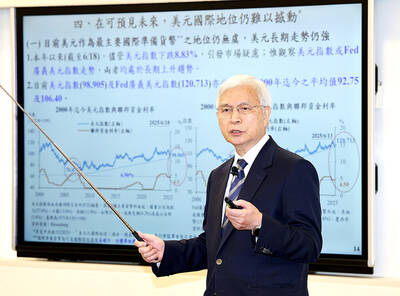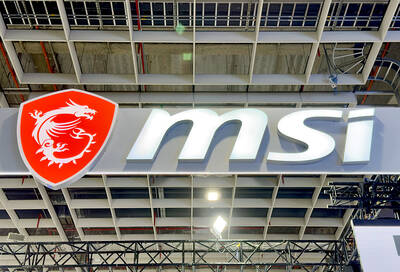Moody’s rating agency said yesterday it could cut Spain’s credit rating again because of the country’s heavy refinancing schedule and problems in meeting its borrowing needs next year.
Moody’s cut Spain’s sovereign debt rating from “Aaa” to “Aa1” in September, adding to the pressures on Madrid and the wider eurozone, and said yesterday that it could now further reduce the rating.
NOT IN QUESTION
It said in a statement that Spain’s solvency was not in question and it would not need external help, but heavy financing requirements would likely create fresh tensions on the money markets.
Additionally, it cited the possibility that higher costs to recapitalize the banking system could increase the public debt and noted concerns over whether the central government can push through reforms given the high degree of autonomy enjoyed by the regions.
“Moody’s believes that the ... downside risks warrant putting Spain’s rating under review for downgrade,” top Spain analyst Kathrin Muehlbronner said in a statement. “However, Moody’s also wants to stress that it continues to view Spain as a much stronger credit than other stressed eurozone countries ... Moody’s review will therefore most likely conclude that Spain’s rating will remain in the ‘Aa’ range.”
Moody’s estimated that the central government needs to raise 170 billion euros (US$225 billion) next year, with the regions needing another 30 billion euros and the banks 90 billion euros.
Raising this money is “now rendered more challenging by the fragile confidence of international capital markets,” it said, noting recent speculation that Spain might have to seek help from the EU and IMF.
Debt-stricken Greece got a 110 billion euro EU-IMF rescue in May when the markets turned against it, meaning it could no longer raise fresh funds at sustainable rates and was faced with the prospect of default.
SPREADING WOES
Ireland was bailed out similarly earlier this month, with Portugal tipped as the next eurozone casualty on a list including Spain and possibly Italy as the eurozone debt and deficit crisis spreads.
Moody’s said it expected Spain to be “able to raise the necessary financing.”
“However, ongoing higher funding costs would strain Spain’s debt affordability further beyond current expectations and could also negatively impact the availability and cost of credit to the wider economy, which remains vulnerable,” Moody’s said.

DIVIDED VIEWS: Although the Fed agreed on holding rates steady, some officials see no rate cuts for this year, while 10 policymakers foresee two or more cuts There are a lot of unknowns about the outlook for the economy and interest rates, but US Federal Reserve Chair Jerome Powell signaled at least one thing seems certain: Higher prices are coming. Fed policymakers voted unanimously to hold interest rates steady at a range of 4.25 percent to 4.50 percent for a fourth straight meeting on Wednesday, as they await clarity on whether tariffs would leave a one-time or more lasting mark on inflation. Powell said it is still unclear how much of the bill would fall on the shoulders of consumers, but he expects to learn more about tariffs

NOT JUSTIFIED: The bank’s governor said there would only be a rate cut if inflation falls below 1.5% and economic conditions deteriorate, which have not been detected The central bank yesterday kept its key interest rates unchanged for a fifth consecutive quarter, aligning with market expectations, while slightly lowering its inflation outlook amid signs of cooling price pressures. The move came after the US Federal Reserve held rates steady overnight, despite pressure from US President Donald Trump to cut borrowing costs. Central bank board members unanimously voted to maintain the discount rate at 2 percent, the secured loan rate at 2.375 percent and the overnight lending rate at 4.25 percent. “We consider the policy decision appropriate, although it suggests tightening leaning after factoring in slackening inflation and stable GDP growth,”

Meta Platforms Inc offered US$100 million bonuses to OpenAI employees in an unsuccessful bid to poach the ChatGPT maker’s talent and strengthen its own generative artificial intelligence (AI) teams, OpenAI CEO Sam Altman has said. Facebook’s parent company — a competitor of OpenAI — also offered “giant” annual salaries exceeding US$100 million to OpenAI staffers, Altman said in an interview on the Uncapped with Jack Altman podcast released on Tuesday. “It is crazy,” Sam Altman told his brother Jack in the interview. “I’m really happy that at least so far none of our best people have decided to take them

PLANS: MSI is also planning to upgrade its service center in the Netherlands Micro-Star International Co (MSI, 微星) yesterday said it plans to set up a server assembly line at its Poland service center this year at the earliest. The computer and peripherals manufacturer expects that the new server assembly line would shorten transportation times in shipments to European countries, a company spokesperson told the Taipei Times by telephone. MSI manufactures motherboards, graphics cards, notebook computers, servers, optical storage devices and communication devices. The company operates plants in Taiwan and China, and runs a global network of service centers. The company is also considering upgrading its service center in the Netherlands into a